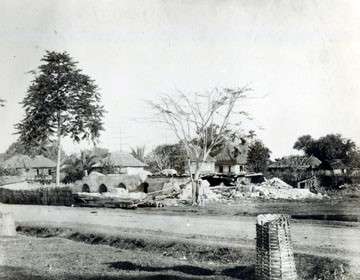The municipality of Binalonan is found at the central eastern plains of Pangasinan and as part of the Tobong-Tolong River System. The Toboy-Tolong (now Sinocalan) River System has its headwater in the mountains that separated Pangasinan from Benguet named Alan and Alagot. Several small streams joined near its watershed, most of them carrying gold particles from gold beds in the mountains during the Spanish Period. (Cortes, 1900: a)
The town of Binalonan served as the crossroad of different cultures such as Pangasinan, Ilocano and Cordilleran culture, thus bearing witness to the growth and development of educational institutions, connecting roads and highways, cultural exchanges and migrations.
The place of Binalonan first appeared on the early 1800’s map of Fraile Murillo Vellarde of the Dominican Order (seen from Cortes, 1975), but the place was declared as an independent municipality from Manaoag in 1834. Its declaration of municipality status has a long history of conflict and animosity between principalias, the first attempt was in 1822 but only approved by 1934. The Sto. Nino church was built in 1841 in accord with its mother parish in Manaoag. The town of Binalonan was sparsely populated and forested during the early 1800’s. How it became an agricultural district has a long history connected with political fiasco, trend in migration and a long defiance to the policies implemented during colonial period.

Sto. Nino Church that features late Baroque architecture | University of Sto. Thomas Archival collection, Espana Manila.
Binalonan as the municipality is now called, evolved from the Ilocano term, “Balon”, synonymous to baon in Tagalog which means packed meal in English. The story, as transmitted through generations, and now part of history, is that during the Spanish Regime, an uninhabited land with crude wooden fence was owned by certain Don Salvador, a resident of Manaoag, Pangasinan. On this land were two camachile trees standing majestically which became a converging point of Ilocano migrant workers who worked on the vast unnamed land of a Pangasinan principalia. This became an area where they enjoyed eating their balon under the shade and breeze of the trees.
When immigrants from Ilocos Region go to Manaoag, Don Salvador told them to proceed to his pastureland, known as the place where people eat their balon, known generally in Ilocano as binnalonan.
Because of the exodus of Ilocano workers and their families to Binalonan, this once obscure and insignificant place, flat and covered with grass, flourished. It grew into a village with social and religious activities. The inhabitants accepted Christianity having been introduced by Father Lizaga. He exerted efforts to transform the community into a Township. Relentlessly, Father Lizaga did not spare time convincing the hierarchy of the religious order to spread the Christian faith in Binalonan.

Ruins of Binalonan municipal building 1890 | Filipinas Heritage Library, Ayala Museum, Makati City Philippines
To establish a town, the application for the license to erect a visita should be done by the cabezas. In 1822, the petition was written by Santiago Corpuz, an Ilocano principalia and cabeza of a migrant community in Manaoag, and Don Josef de la Costes, a native principalia from Mangaldan. In the year 1832, another petition was submitted by the gobernadorcillos and principalias of Manaoag that included 22 more signatories and was supported by the new parish priest, Julian Yzaga O.P. The town attained its civil independent municipality status by 1834 through the efforts of Don Josef Cortes and the twenty two principalias namely: Josef de la Cruz, Josef de la Peralta, Francisco Garcia, Perdo Xavier Domingo, Isidro Salvador, Bartolome Prado, Pedro Theodoro, Raymundo Garcia, Castro Guico, Eugenio Barrozo, Juan de la Cruz, Santiago Lorenzo, Domingo M(e)ilicio, Bartolome Domingo, Buenaventura Oaring, Agapito de los Santos, Silvestre de los Santos, Vicente Prado, Miguel Mangsat, Pedro Domingo, Juan Garcia Barnela, and Felez Eustaquio.
However, Binalonan remained in ecclesiastical terms as a visita of Manaoag, thereby becoming the first town to be established with the chronological emergence of Ilocano settlements in the province of Pangasinan. The approval of Binalonan was shortly followed by Urdaneta (1858), San Manuel (1860), Alava or present-day Sison (1896), Pozorrubio (1868), and Alcala. In 1836, Don Silverio Delos Santos, the Gobernadorcillo of Manaoag took over the reign of Binalonan community until the erection of it’s own visita, the Sto. Nino Parish Church, in 1841.
Sources
- Bulosan, Carlos (1946). America is in the Heart: personal History. New York: Harcourt Brace and co.
- Cortes, Rosario (1990).Pangasinan, 1901-1986: a political, socio-economic and cultural history. Quezon City: New Day Publisher.
- Cortes Rosario (1975).Pangasinan: 1572-1800. Quezon City: New Day Publisher.
- Mangahas Fe and Pasalo, Virginia (2015. Pangasinan Pinablin dalin: history, culture and development. Lingayen, Pangasinan: Pangasinan Historical and Cultural Commission.
- Quintos, Felipe (1947). Breves relatos de la revolucion en Filipinas. Manuscript written by the author, preserved at the Filipiniana section of the University of the Philippines Diliman Main Library.
Province: Pangasinan
District: 5th District, Pangasinan
Founded: 1834
Barangays: 24
Government:
- Mayor: Hon. Ramon Ronald V. Guico IV
- Vice Mayor: Hon. Bryan Louie R. Balangue
Land Area: Total of 47.57 km2 (18.37 sq mi)
Population (2010):
- Total of 52,832
- Density of 1,100/km2 (2,900/sq mi)
ZIP code: 2436
Dialing code: 75
Income class: 1st class; partial urban
Town Fiesta: February 18-22
Products: Sugar cane, rice, feeds, cornik, basi/tuba, ornamental plants & earthen pots
Educational institutions in Binalonan are as follows:
Public Primary Schools/Elementary (22):
| North Central School | Moreno Elementary School | Sumabnit Elementary School |
| Bugayong Integrated School | San Felipe Elementary School | Pasileng Elementary School |
| Camangaan Elementary School | Sta Catalina Elementary School | Tabuyoc Elementary School |
| Capas Elementary School | Sta Maria Elementary School | Bued Elementary School |
| Casantiagoan Elementary School | Vacante Elementary School | Balisa Elementary School |
| Cili Elementary School | South Central Elementary School | Santiago Elementary School |
| Dumayat Elementary School | Balangobong – San Pablo Elementary School | Mangcasuy Elementary School |
| Linmansangan Elementary School |
Private Primary Schools/Elementary (7):
| Angel’s Learning Center | Lubic Christian Academy | Sta Fe Learning Center |
| Binalonan Nazarene Christian Academy | Math Excellence Academy of Binalonan | Holy Child Academy |
| Ovidio Vijungco Learning Institute |
Public Secondary Schools (6):
| Juan Macaraeg National High School | Batasan National High School | Sumabnit National High School |
| Sta Maria National High School | San Felipe National High School | Bugayong National High School |
Universities (3):
| University of Eastern Pangasinan | WCC Aeronautical and Technological College |
| Manantan Technical School |
Ikaw, ako, tayong lahat may banal na tungkulin
Inaasahan ng dakilang bayan natin
Sa Maykapal italaga ang mithiing kaunlaran
Tungo sa maningning na kinabukasan
Pagsikapang matuto ng bagong kaalaman
Palawakin natin ang dunong at kakayahan
Palawigin ang saklaw at ang hangganan
Ng ating adhikain at isipan
Koro:
BINALONAN ANG GALING!
Bayang dakila at magiting
Makadiyos, marunong at malinis na pamayanan
Taas noo at buong karangalan
Itinatanghal ang bayan ng Binalonan!
Bayan natin may malinis na kapaligiran
Bunga ng panatag na kalooban
Tahimik at payapang mga lansangan
Masaya at masaganang taong-bayan
(Ulitin ang Koro)
Tulay:
Isigaw! Ipagsabi! Ipagmalaki!
Bayang tinatangi bigyang dangal lagi
Paninindigan at kahusayan ng ating lahi
Sa lahat ng panahon, ating ipagbunyi
(Ulitin ang Koro)
We, your people, come before you with humility and admiration
We bow before your presence in thanksgiving and adoration
For the countless blessings that you have bestowed upon
Your beloved town, Binalonan
Almighty God,
We, your people ask for your enduring spirit
Ignite us to be strong in our faith, righteous in our work
Wise in our understanding, humble in our talk
Steadfast in our service
And united in our cause
Almighty God,
Because you have given us so much
And much is required of us to give in return
We commit to you an excellent and Godly community
A place where as strong foundation wrests on the family
A place we call our home, a haven for peace
Our beloved town, Binalonan.
This we pray in Christ’s name, Amen.
